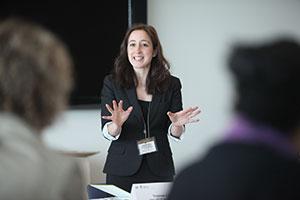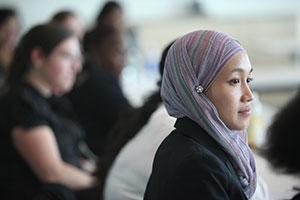Master Mediator: Professors Innovative Work Shines Spotlight on the Art of Mediation
Professor Alexandra Carter '03 has trained U.N. delegates, led a Native American peacekeeping course, and taught Brazilian judges how to use mediation to settle disputes.
New York, Oct. 2, 2012—In a conference room overlooking the East River at the United Nations headquarters in New York City last month, Associate Clinical Professor of Law Alexandra Carter ’03 huddled with two women playing the parts of prime ministers.
Only moments before, the women had pushed back their chairs in satisfaction, celebrating a successful role-play in which they had negotiated an end to a fictional armed conflict over biological warfare research. But after a few minutes, the pair—actual delegates from Egypt and Haiti who were in town for the 67th U.N. General Assembly—worried they had done something wrong by finishing so quickly.
Prof. Alexandra Carter leading workshop, "Women Negotiating Peace" |
“Let me get this straight,” Carter deadpanned, as she looked from one pretend prime minister to another. “You’re saying you’ve come to a mutually beneficial agreement, and you’re asking me if you did anything wrong?”
She paused.
“I just want to reflect that back to you,” she finished, breaking into a grin as the women began to laugh.
Carter devised the simulation, with the help of research fellow Ashley Simpson ’12, at the request of the United Nations Institute for Training and Research for a first-of-its-kind training for female U.N. delegates. The fictional role-play, in which delegates from 23 countries participated, was designed to address a very real problem: Female diplomats sign less than 3 percent of international peace agreements compared to their male counterparts.
| A Malaysian delegate at Carter's training. |
Working with world leaders is just one of the ways Carter and other faculty members in the Alternative Dispute Resolution program at Columbia Law School are sharing their expertise, helping not just students but also real-world practitioners learn to be better at conflict resolution.
In this past year alone, Carter created and taught a Native American peacekeeping class with the help of some of the Law School’s Native American students; traveled to Oklahoma to be trained in peacemaking by members of the Chickasaw Nation; and taught a weeklong mediation course in Brazil for prosecutors, public defenders, and judges. Her session at the United Nations earlier this month was her second since 2011.
“My goal is for people to see Columbia Law School as an innovator in the field of mediation,” she said.
Carter directs the Mediation Clinic founded in 1992 by Clinical Professor of Law Carol B. Liebman. While participating in the clinic, students mediate actual disputes in a wide variety of government and private settings.
Shawn K. Watts ’12, a Cherokee student in Carter’s Fall 2011 Mediation Clinic, helped come up with the idea for the Native American peacekeeping course. Now an associate at Sheppard Mullin Richter & Hampton, he said the clinic provided an invaluable chance to get hands-on experience.
“This is different than being in a class,” he said. “We were taking real cases with real people whose lives were different after we walked out, either because we could help them or because we couldn’t.”
Liebman, who retired from teaching the clinic two years ago and now serves as founding director, said Carter is doing a fabulous job raising the profile of the Law School’s mediation curriculum.
In addition to its mediation offerings, the Law School’s ADR program boasts courses on the basics of negotiation, dealmaking, transnational arbitration, and World Trade Organization dispute settlements. It also hosts myriad conferences, seminars, workshops, and symposiums.
The idea behind the program is to teach people to look beyond litigation and attempt to resolve disputes outside the courtroom.
While a student at Columbia Law School less than 10 years ago, Carter enrolled in the Mediation Clinic on the recommendation of a friend, and she ultimately served as a teaching assistant under Liebman. The experience changed the trajectory of her career, but it took her a while to shift away from pursuing trial work.
Following graduation from the Law School, Carter worked as a litigation associate at Cravath, Swaine & Moore. In one prospective representation, a famous artist came to the firm distraught over a dispute with a longtime collaborator. At the first meeting, the partner in charge rattled off a list of potential claims the artist could bring, but Carter felt the woman wanted something more.
“I could see on her face that we were not giving her what she needed,” Carter recalled. “What she really needed was a process that would allow her to sit down with this person and figure out something that was going to let their project go forward.”
Carter eventually decided that she preferred mediation and negotiation to litigation and changed career paths. Now, she tries to teach her students—at the Law School, the United Nations, Brazil, and elsewhere—that for parties in opposition, the act of sitting down together can be hugely beneficial.
“I really believe that people know best how to solve their own problems,” she said. “My job is to help create a process that allows them to do that.”

